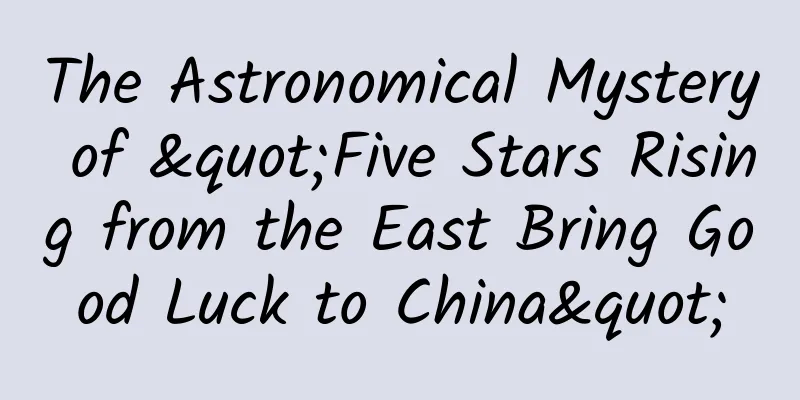The Astronomical Mystery of "Five Stars Rising from the East Bring Good Luck to China"

|
Produced by: Science Popularization China Author: Li Jingjing (Xinjiang Astronomical Observatory, Chinese Academy of Sciences) Producer: China Science Expo Recently, the dance drama "Five Stars Rising from the East" is touring the country. The actors' dancing is not only graceful and beautiful, but also combines oriental beauty with rich western customs, which has amazed the audience. Hearing the name of this dance drama, I believe many smart friends will immediately think of the famous national first-class cultural relic - the "Five Stars Rising from the East, Prosperous China" Han-style brocade arm guard unearthed from the Niya Ruins in Hotan, Xinjiang. Yes, the concept and theme of this beautiful dance drama originated from it. Video source: CCTV However, what does "Five stars rise in the east, bringing good luck to China" mean? Which five stars are these? What did the ancients know about them? This article will answer these questions one by one. Dance Drama "Five Stars Rising from the East" (Photo source: Stills from "Five Stars Rising from the East") A miracle of cultural relics in the sea of sand In October 1995, deep in the desert 150 kilometers north of Minfeng County in Hotan Prefecture, Xinjiang, members of the Sino-Japanese joint academic expedition team were conducting intensive and orderly archaeological excavations at the Niya site. They discovered a large number of relics and artifacts left over from the lives of ancient people, including houses, tombs, pottery, wood, iron, and grain crops from the Han and Jin dynasties. In the tomb numbered M8, there was a couple dressed in gorgeous clothes. On the right arm of the male tomb owner was tied a brightly colored and eye-catching arm guard. After the archaeological team unfolded it, they found eight seal-style Chinese characters on it: "Five stars rise in the east, bringing good luck to China". The situation when the brocade armguard with the inscription "Five stars rising in the east bring good fortune to China" was unearthed (Image source: Reference 2) This brocade arm guard is a rounded rectangular piece, 18.5 cm long and 12.5 cm wide, with three white silk ribbons about 21 cm long and 1.5 cm wide sewn on each of the two long sides. From right to left, the arm guard is woven with red, yellow, blue, green and white warp threads in turn, with animals such as phoenix, phoenix bird, unicorn, white tiger, as well as traditional auspicious patterns such as cloud patterns, grass and stars, and the seal characters "Five stars rise in the east, benefiting China" are located on the upper and lower sides of the long side, forming an organic whole with the pattern. The full view of the brocade armguard with the inscription "Five stars rise in the East, bringing prosperity to China" (Image source: Reference 4) According to carbon 14 dating, the Niya site in Xinjiang is about 1,800 years old, which was the Han Dynasty in the Central Plains. When this Han-style brocade arm guard was unearthed, the color was very bright and the pattern was full of auspiciousness, as if it had been buried not long ago. Despite the passage of thousands of years, it still appears in its complete appearance before our eyes, which is amazing! The astronomical meaning of the arm guard The brocade armguard with the inscription "Five Stars Rising from the East, Bring Good Luck to China" is known as one of the greatest discoveries in Chinese archaeology in the 20th century, not only because it demonstrates the superb brocade weaving technology of the Han Dynasty, but also because these eight Chinese characters reveal the concept of the correspondence between heaven and man in Han Dynasty society and the ancient people's understanding of celestial phenomena behind it. We know that ancient China attached great importance to observing celestial phenomena, on the one hand for the needs of calendar and agriculture, and on the other hand driven by the theory of correspondence between heaven and man. The ancients emphasized the correspondence between heaven and man, and corresponded things happening on earth with the stars in the sky. If the stars in the sky changed, then the people or things corresponding to them would definitely change accordingly. Although it seems that the theory of celestial communication has no scientific basis, it does contain the ancient people's observation and cognition of celestial phenomena. In fact, ancient Chinese astronomy and astrology were born together, complementing and promoting each other. In ancient China, the so-called "five stars" refer to the five planets in the solar system, namely Mercury, Venus, Jupiter, Mars and Saturn, also known as Chenxing, Taibai, Suixing, Yinghuo and Zhenxing. "East" refers to a specific position in the sky in ancient Chinese astrology, which is the direction of the sky defined by the ancients. "China" is a geographical concept, referring to the Central Plains region in the middle and lower reaches of the Yellow River under the jurisdiction of the Han Dynasty. In summary, "five stars rise in the east" refers to the five planets, Mercury, Venus, Mars, Jupiter and Saturn, which are arranged in a line from high to low and hang above the eastern horizon. As for "benefiting China" , this is because this peculiar astronomical phenomenon is both spectacular and rare, and it may only be seen a few times in thousands of years. Therefore, the ancients attached great importance to it and gave it great astrological significance, considering it as a good omen, especially beneficial to military and national affairs. Therefore, the saying "five stars coming out of the east is good for China" often appears in ancient documents. The earliest record found so far is in the "Records of the Grand Historian: Book of Celestial Officials", which states: "Five stars are divided in the sky. If they gather in the east, China will benefit; if they gather in the west, foreign countries will benefit from using military force. The five stars all come from the star Chen and gather in one house. The country in which they gather can follow their example to conquer the world." After the establishment of modern astronomy, although we already know that the phenomenon of "five stars rising in the east" is relatively rare, it is actually just a normal astronomical phenomenon. The reason for its occurrence is that the five planets, Mercury, Venus, Mars, Jupiter, and Saturn, revolve around the sun along their respective orbits. At special moments, they will appear to be very close visually, so they can be observed by the ancients in roughly the same direction with the naked eye. This astronomical phenomenon has nothing to do with the human affairs, disasters and blessings on Earth. "Five stars gather together" (Image source: Stellarium) Ancient Chinese Understanding of the "Five Stars" We mentioned earlier that ancient Chinese astronomy and astrology were born together, and the two complemented and promoted each other. The ancients actually began observing the five stars as early as the Pre-Qin period, and they also gave them more oriental names based on their respective characteristics. Mercury, the ancients called it "Chenxing" . Because when you look at Mercury from Earth, you will find that Mercury appears to the left of the sun for a while, and then appears to the right of the sun. Its maximum angular distance from the sun does not exceed 30°, and the ancients called 30° one Chen, so it is called "Chenxing". Venus was named "Taibai" by the ancients because it is the brightest of the five stars and the brightest star in the entire sky besides the sun and the moon. In fact, Venus had two other names in ancient times, "Qiming" and "Changgeng". This is because Venus is very close to the sun and can only be seen when the sun is about to rise or shortly after it sets below the horizon. The ancients initially thought that these were two different stars, so they named the morning star "Qiming" and the evening star "Changgeng". The well-known "Book of Songs·Xiaoya·Dadong" contains the verse "In the east there is Qiming, in the west there is Changgeng, there is the journey of picking up the sky and carrying the gods". The "Qiming" and "Changgeng" here refer to Venus. Jupiter was called "Sui Xing" in ancient times . This is because the ancients found through observation that Jupiter orbits the sky approximately every 12 years, passing through a different specific starry sky area every year, and returning to the same position after 12 years. Therefore, the ancients used the movement law of Jupiter to record the years and called Jupiter "Sui Xing". This method of recording years is also called "Sui Xing calendar". Mars, also known as "Yinghuo" , is named for its fiery red color, which means "flashing fire, confusing and confusing". The famous astronomical phenomenon in ancient China, "Yinghuo guarding the heart", refers to the phenomenon that Mars "stays" (moves nearby for a period of time) in the heart, which is also considered a very ominous astronomical phenomenon. Saturn was called "Zhenxing" or "Tianxing" by the ancients . This is because Saturn takes about 28 years to orbit the sky, and every year it stays in one of the 28 mansions (the ancients divided the entire sky into 28 mansions). It was described as "filling one mansion every year, so it is called Tianxing", and Saturn got its name from this. During the Han Dynasty, due to the popularity of the theory of the Five Elements and Yin and Yang , the ancients attached them to the five stars, and thus the names we are familiar with and still use today, namely Mercury, Venus, Jupiter, Mars, and Saturn, came into being. The sun, moon and five planets in the Seven Planets Diagram (Image source: Reference 3) In addition to the above-mentioned knowledge of the positions, brightness and colors of the five stars, the ancients also paid attention to the most important laws of the five stars' motion . Starting from about the 4th century BC, ancient Chinese astronomers have been observing, calculating and recording the positions of the five stars. With the continuous development of ancient science and astronomy, astronomers no longer associated the knowledge of the five stars with astrology, but pursued high-precision planetary calculations , which made the ancient Chinese's understanding of planetary motion shift from perceptual to rational, and gradually embarked on a scientific path. Conclusion The "Five Stars Rising from the East" Han-style brocade armguard was buried thousands of years ago, lying quietly in the depths of the desert through countless seasons, waiting for its reappearance a thousand years later. Today, when we have the opportunity to gaze upon this thousand-year-old artifact in the Xinjiang Museum, we not only know that it represents the superb brocade craftsmanship of ancient China, and shows the richness and diversity of culture along the Silk Road, as well as the exchange and mutual learning, but also understand the understanding and exploration of the sea of stars by ancient Chinese astronomers. Due to the limitations of the scientific development level at that time, the understanding of the five stars by ancient Chinese astronomers inevitably had some limitations, such as strong astrological color and subjective imagination, but this does not prevent us from taking the essence and discarding the dross, interpreting the scientific elements contained in it, and realizing the ancient Xinjiang people's recognition of Chinese civilization, as well as the interpretation of the theme of people of all ethnic groups "holding together like pomegranate seeds" and forging a strong sense of community for the Chinese nation. Through the small arm guard, we can encounter the splendid China thousands of years ago. References: [1] Zheng Na. “Five Stars Rising from the East” Activates the Thousand-Year-Old Imagination [N]. People’s Daily (Overseas Edition), 2022-02-28 (007) [2] National Treasure Season 2 [3]Li Liang. On the first day of the first lunar month, a rare astronomical phenomenon will appear: "the sun and the moon rise together, and the five planets align in a row"! [EB/OL]. [2021.2.12]. Science Popularization China [4] Yu Zhiyong. A preliminary analysis of the colorful brocade inscription “Five stars rise in the east, good for China” unearthed in Niya, Xinjiang [J]. Western Region Studies, 1996(03):43-46. [5] Jiang Xiaoyuan. Planetary astrology in ancient China: a preliminary study of astronomy, morphology and sociology [J]. Exploration of Nature, 1991(01):107-114. [6] Tang Quan. Current status and prospects of research on ancient Chinese planetary theory[J]. Philosophy of Science and Technology, 2013, 30(05) :82-88. [7] Wu Shouxian, Liu Ciyuan. Records of planetary positions in ancient China[J]. Journal of Shaanxi Astronomical Observatory, 1986(01):1-4. |
>>: The Lancet sub-journal: 5 good habits that can help Chinese people live longer
Recommend
Is it worth a fortune to stay slim in old age? Even if you are thin, you must have muscles and bones!
As the saying goes, "It's worth a fortun...
A guide to creative optimization of information flow in four popular industries: e-commerce, automobiles, games, and tourism
Information flow advertising has now become an es...
If you want to promote Tik Tok with zero basic knowledge, you must read these 8 points!
The editor’s TikTok has exploded! My Douyin accou...
YouTube reveals: 5-second ads earn more than 120-second ads
Last weekend, I opened an app and was about to wa...
These Motos, those models.
Editor's note: Every change of MOTO in those ...
Is it expensive to rent a small video server?
Is it expensive to rent a small video server? Now...
Tips for APP promotion, double the effect!
Many optimizers often encounter such troubles dur...
Can't tell the difference between elk, moose and reindeer? What kind of deer does the English word "elk" refer to?
In this age of Internet development, when we come...
How to create a Douyin IP expert and share the tips on how to gain fans!
Everyone is familiar with the word "Tik Tok&...
Japan bets on all-solid-state batteries, 23 companies jointly develop
Japan's New Energy and Industrial Technology ...
One-third of children do not get enough sleep. How much sleep do children need in a day?
Just as electronic devices need to be charged, sl...
2015 Google I/O conference will be held on May 28
On February 11, Google announced that the 2015 I/...
Reflections on the failed Meituan iOS interview
Daily nonsense Since last year, I have been tryin...
Peppa Pig’s popularity in various ways: what lessons can we give to marketers?
The most popular cartoon character today is Peppa...
Glowing plants are here! Maybe they will be your next desk lamp?
In the fantasy world of literary works, glowing p...






![[Popular Science of Chinese Military Technology] How does the “Flying Leopard” fighter jet soar into the sky?](/upload/images/67f2507ac8a8c.webp)


